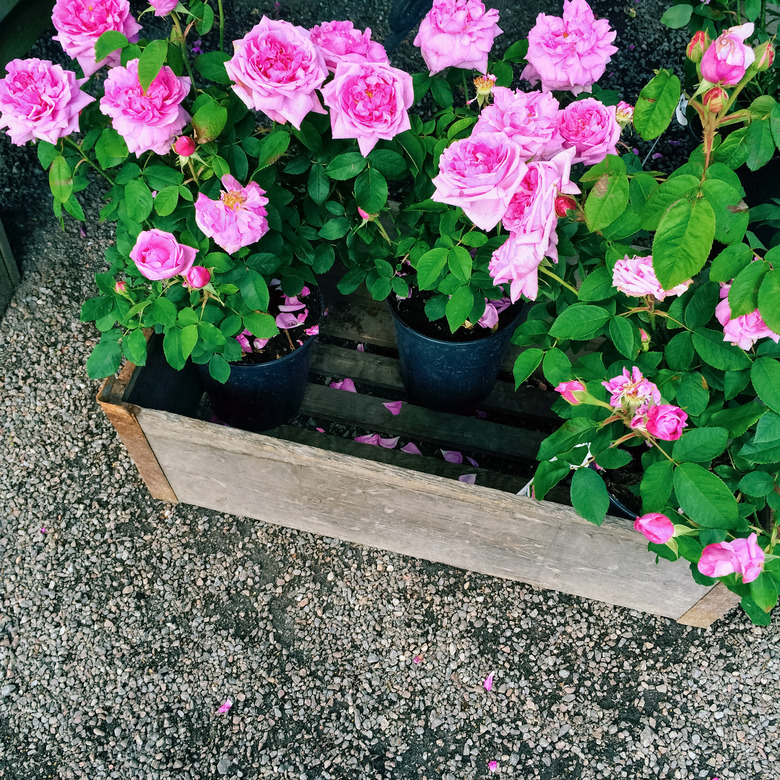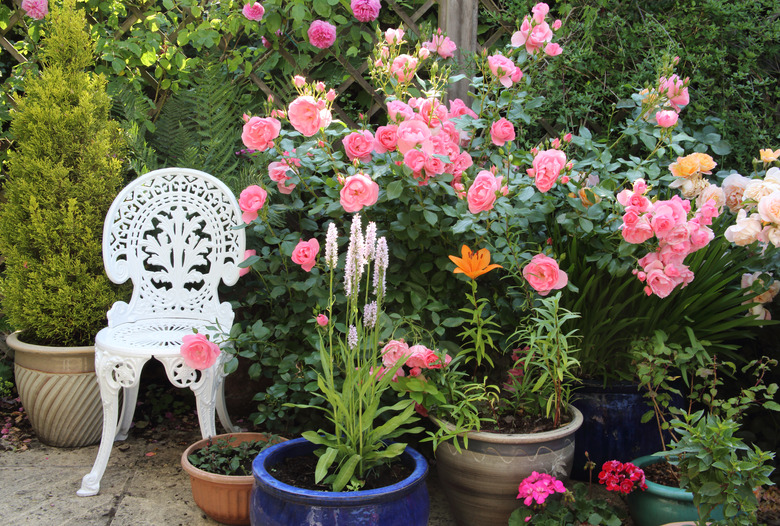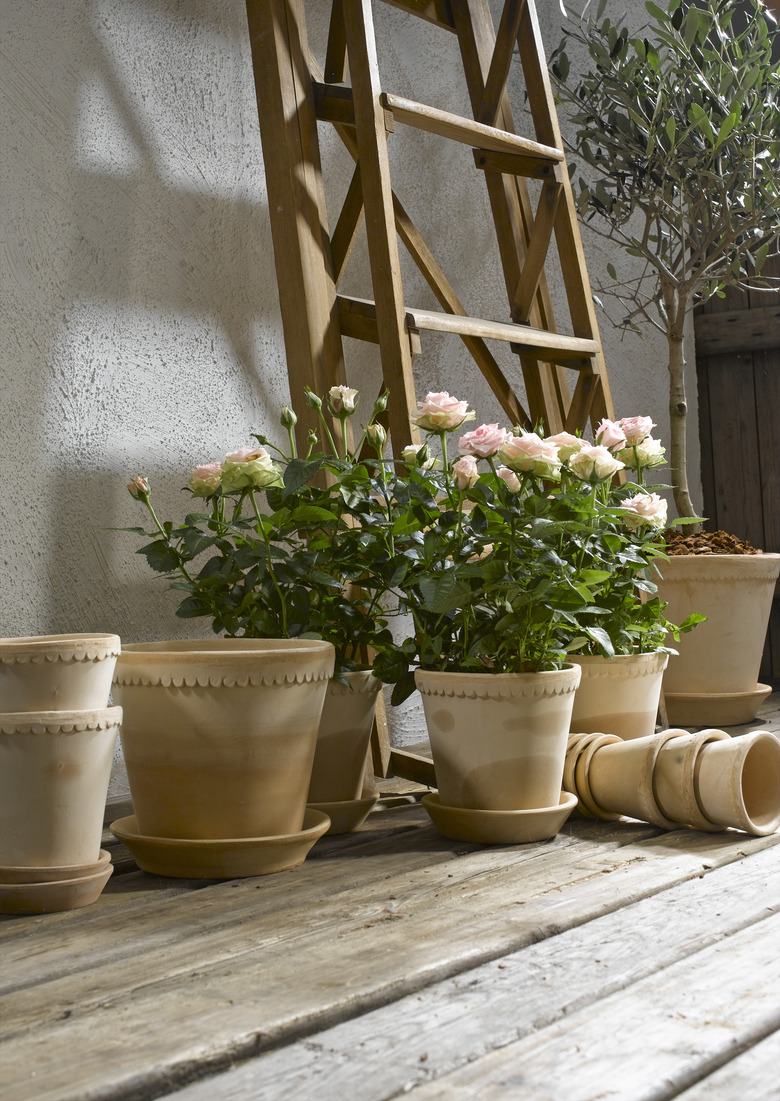A Beginner's Guide To Growing Container Roses
We may receive a commission on purchases made from links.
Container roses are a fantastic addition to any porch, patio or balcony garden, even for novice gardeners. They can add a splash of color and heavenly fragrance to your home from spring all the way through fall. While they are fairly easy to care for once established, roses are heavy feeders, which means they have some particular needs that are important to keep in mind so they can continue to thrive year after year.
Choosing Roses for Container Gardens
Choosing Roses for Container Gardens
While some roses (Rosa spp.) are better adapted to container gardening than others, almost every type of rose can survive and thrive in these conditions with the exception of large climbing roses. The easiest roses to grow in containers are miniature roses and polyanthas, but even shrub roses and smaller climbers can do well in containers with proper care. For best results, stick with roses that have a maximum height and width of less than 5 feet, are disease-resistant and repeat their blooming.
When opting for miniature roses, don't just grab some cute potted roses from your local grocery store, as these are intended as gifts and are often poorly adapted to the local climate where they are being sold. Bear in mind that while miniature roses are often sold when they are under a foot tall and have tiny leaves and flowers, they are still young and can grow up to 3 feet tall at maturity. Find a miniature rose variety that will do well in your area and be sure to select a container at least 12 inches wide to provide a space large enough for the fully grown rose.
Repeat-blooming roses will keep flowering throughout the growing season, more profusely if you remove the spent blooms, unlike once-blooming roses, which will only bloom once a year. While many people like the sturdiness of once-blooming roses, which are better adapted to drought and neglect, most gardeners prefer continuous-blooming roses since they add so much more color and texture to the landscape/your home.
Whatever size rose you select, keep in mind that roses grown in containers tend not to grow as large as those grown directly in the ground. You can also reduce the plant's size a little more through proper pruning.
Choosing the Right Container
Choosing the Right Container
One of the most important factors when selecting a container is to select one that is the right size for the rose you plan to grow. While a miniature rose bush may do fine in a 5-gallon container, shrub roses around 5 feet tall grow best in a 20- to 30-gallon container. An undersized container prevents your rose from thriving. When in doubt, always lean toward using a larger container, as more room doesn't just allow the roots to spread out but helps maintain more moisture in the soil.
- Miniature,
miniflora and small polyantha roses should have a 5-gallon container at
least 15 inches deep. Overall, these are the only roses that do well in window
boxes and hanging baskets. - Smaller
floribundas, larger minifloras and most polyantha roses call for a 10-gallon container. - Large
floribundas, hybrid tea, grandiflora and small to medium shrub roses need a
15-gallon container. - Large
shrub and climbing roses (up to 5 feet high and equally wide) require a 20-
to 30-gallon container.
Roses can be planted in smaller containers when young as long as you plan to transplant them to larger containers later. When transplanting to a bigger container, select one that is one or two sizes larger. Also, if you plan to grow your roses with any companion plants, choose a slightly larger container than your rose might need on its own.
Aside from guaranteeing your rose bush container is big enough to accommodate the plant's large roots, ensure the pot has sufficient drainage, meaning it has at least one drainage hole. The larger the pot, the more drainage holes you'll need. Without proper drainage, the roots may rot in overly wet soil. Also make sure that the drainage holes are large; small holes can become clogged by roots that grow through the holes into the soil below the pot, which prevents water from draining, and small holes may not allow the potting mix to drain quickly enough. Don't add any drainage material to the bottom of the pot, as this will just take away space from your rose's roots.
When it comes to material, resin, plastic and terra-cotta clay are all fine. Clay is heavier, meaning it is harder to move, and it can crack in freezing temperatures, but it is preferable to plastic in warm climates since it keeps the roots cooler in hot weather. Lighter-colored plastics are preferable in all but the most northern climates, as they heat up less quickly than dark plastics. Always ensure plastic or resin containers are weatherproof.
Where to Place Container Roses
Where to Place Container Roses
Roses need full sun, at least five hours of the day and ideally more. The more petals on a rose, the more sun it requires to produce large, healthy blooms. Remember that the more sun a rose gets, though, the more water it will need.
Aside from sunlight, it's also important to ensure your rose bush gets good air circulation. This means containers should be spaced at least 2 feet away from other plants to reduce excess moisture, which can result in fungus-related diseases. For bigger roses, a good rule of thumb is to give each rose a space at least two-thirds as wide as the plant's expected height. If you plan to grow any companion plants in the same container as your roses, be sure not to overplant, as this can cause competition for root space and can reduce airflow.
Planting Container Roses
Planting Container Roses
The best time to plant container roses is in early spring after the last frost in your area. Use a good-quality potting mix and amend it with up to 1/3 rich organic matter, such as garden compost. You may also want to add some perlite to improve drainage and bone meal, blood meal or fish meal to boost the nutrients in the soil, which can be useful because even newly planted roses are heavy feeders.
Fill containers about two-thirds full with soil and then gently place the rose plant on the soil, spreading out the exposed roots. Backfill the hole, softly pressing down the soil as you go. The soil should be level with the crown or bud union where the canes protrude from the rootstock. Add a 2-inch layer of mulch to the top of the soil, keeping it 2 inches away from the crown. Slowly water until the soil is thoroughly moist and water flows from the drainage holes.
Caring for Container Roses
Caring for Container Roses
Because container roses dry out quicker than those grown in the ground, be sure to check the soil moisture regularly, particularly in hot weather, when you may need to water as often as twice a day. To do so, place your finger 1 inch deep into the soil. If it is dry, water until excess water flows from the drainage holes. Do not water when the soil is already moist, as this can result in root rot, reduced bloom quality and conditions that encourage fungal diseases.
Adding mulch to the soil will help maintain moisture and prevent weeds from spreading. Maintain a 2-inch layer of mulch on the soil to keep your plants healthy. Before adding more mulch, make sure the soil level is sufficient. If the roots start to become exposed, add more soil first.
Twice a year, flush the soil by watering for as long as five to 10 minutes depending on the size of the container. This will flush the salt that has built up in the soil from tap water, rainwater, or fertilizer which can kill any container-grown plant.
Just as container plants require more water, they also require more fertilizer. Once a month, use a commercial slow-release variety, bone meal, compost, fish meal or blood meal because traditional fertilizer can easily burn container plants.
Because roses are such heavy feeders, they will deplete the soil of nutrients after a few years even with regular fertilizing. This means every two to three years, you should replace the soil in late winter when the rose is dormant. This is also a good time to either transplant roses that have outgrown their containers or prune the roots if you do not want to move the plant to a new container. To root prune, just trim the roots back a little near the ends where they have become too crowded, and they will quickly be replaced by new roots.
Pruning Container Roses
Pruning Container Roses
While all roses can use occasional pruning, the amount you need to prune will vary based on the variety. Larger roses often do well when pruned back severely every year, which will also help ensure they don't outgrow the container. This could be too much for a smaller rose bush, though, which is why you should look up specific pruning instructions for your rose variety.
Regardless of the variety of rose you're growing, pruning should generally done in late winter to early spring and should involve a little shaping of the bush as well as the removal of suckers, which should improve airflow and light penetration in the whole plant. It's also important to deadhead flowers after they die. Deadheading can not only make your bush look more attractive but also helps spur repeat-blooming roses to produce more flowers.
Winterizing Container Roses
Winterizing Container Roses
It's important to recognize that because soil in containers freezes more easily than garden soil, extra care needs to be taken to protect container roses from cold weather. A good rule is that your rose will lose two to three hardiness zones when grown in a container. For example, a rose that is normally hardy to zone 3 will only be hardy to zone 5 or 6 in a container. Larger containers provide more protection than smaller containers, as it takes longer for the soil to freeze. Generally speaking, anyone living in zone 7 and above doesn't need to worry about winterizing roses.
For roses grown in small and medium containers, it can be a good idea to take the plant into a garage or shed during the winter. Place the container on wooden blocks to isolate the plants from the cold concrete, and lightly water only occasionally to keep the roots from drying out. While you want to keep the soil from freezing, it's best to avoid wintering roses inside your home, as they need to stay below 50 degrees to go dormant, and preventing them from doing so could greatly impact the number and quality of blooms you get in the following year.
Roses in larger containers fare better in cool weather because their soil does not freeze as easily. While you may not want to or be able to move these plants indoors during the winter, they should at least be placed somewhere they are protected from chilly winds, and if they are placed near a window in your home, they could benefit from heat escaping from inside. Just after the first frost, wrap burlap or chicken wire around the outside of the pot all the way up to the top of the canes and then apply a layer of mulch thick enough to cover the majority of the canes. Then, loosely cover the rest of the plant with burlap, a blanket or a heavy sheet to protect it from frost, wind and sunlight, which could prevent it from going dormant.
Whether you plan to leave your roses inside or outside, stop fertilizing all container-grown roses by the end of August and continue watering as needed throughout winter since containers do not maintain soil moisture like ground soil, and dry roots will kill roses.
References
- University of Illinois: Our Rose Garden – Pruning
- Joy Us Garden: Roses We Love for Container Gardening
- Plant Care Today: How To Use Epsom Salt For Roses
- GrowJourney: Finally! Garden Pot Sizes Decoded
- Midwest Gardening: Growing Roses in Containers
- Midwest Gardening: Winterizing Container Roses
- GardenZeus: 6 Tips for Growing Roses in Containers
- University of Illinois: Our Rose Garden – Planting


